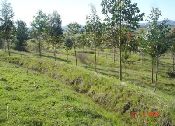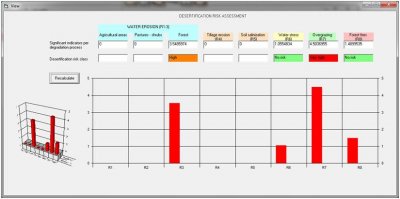| Evaluating the desertification risk assessment tool with local experimental results |
 |
|
Author: Victor Jetten
Introduction Like many Mediterranean countries Portugal suffers from forest fire due to its dry and hot climate. The problem is not only degradation of forest and the emission of carbon dioxide to the atmosphere but it also increases soil losses and pollution of water and air. The Mação Region in Portugal suffered massive fires in 2003 and 2005 affecting more than 70% of the municipality area. To protect the forest from wild fire strip network is constructed. The Vale Torto area near Góis in Portugal was burned by several fires in the 1970s and the early 1980s. Similarly the Camelo catchment near Góis also suffers from forest fire with the recent fire taking place in July 2008. Experiments included strip corridors (Macao) and prescribed burning (Vale Torto).
The area has shallow Cambisols (< 30 cm deep) over metamorphic shists and steep slopes. The main vegetation is pine forest, Eucalypt and shrubs, but fire destroys this and decreases the vegetation cover. The climate shows a strong seasonality despite the overall high precipitation (600-1000 mm per year) with dry summers. The landscape has steep slopes and a deeply incised drainage system.
Desertification indices
Oddly enough the desertification index scores highest for overgrazing, and fire risk, for which the area is known, scores only as low risk. The fire risk depends on land use intensity which is difficult to estimate: if tourism is counted (which is one of the causes of forest fire) and the land use intensity is increased from low to high, the fire risk increases also from 1.49 to 1.65.
Water erosion and overgrazing give the highest risk factors, respectively 3.8 and 5.4 for an intact forest with a cover of 0.5-0.75. The fire risk is low: 1.7 and there is no water stress. After a forest fire with a low cover and high percentage of forest fire these values change to 4.5 for water erosion and 4.7 for overgrazing, presumably because there is less vegetation to graze upon.
The fire risk is not affected by the burning. This may indicate a false effect: in reality a forest fire would decrease the fuel load available and greatly decrease the risk. This is in fact the purpose one of prescribed burning, which is one of the control measures tested in the project. Fire protection also hardly affects fire risk, the index decreases from 1.65 to 1.48, both in the low risk zone.
Conclusions
|
Study sites

Acknowledgement
The DESIRE project was
|
DESIRE brought together the expertise of
26 international research institutes
and non-governmental organisations.
This website does not necessarily
represent the opinion of the
European Commission. The European
Commission is not responsible for
any use that might be made of the
information contained herein. 



